Australia 1993 "Australian Dinosaur Era"
| <prev | back to index | next> |
| Issue Date | 01.10.1993 |
| ID |
Mint /
Self-adhesive Michel: 1370-1375, Bl. 15 (15I, 15II) / 1376-1377, Booklet 78 ; Scott: 1343-1347, 1347a-c / 1348-1349 ; Stanley Gibbons: 1423-1428, MS1429 / 1430-1431 Yvert: 1328-1333, BF20 (21,22) / 1334-1135 ; Category: pR |
| Designer |
Stamp and cover illustrations: Peter Trusler, Melboume, Australia. Scientific consultant: Professor Pat Vickers-Rich, Chair of Paleontology, Monash University. Typography: Sue Passmore, Australia Post Graphic Design Studio |
| Stamps in set | 6 |
| Value |
45c - Ornithocheirus 45c - Leaellynasaura 45c - Allosaurus 45c - Timimus 75c - Muttaburrasaurus $1.05 - Minmi |
| Emission/Type | commemorative |
| Issue place | Muttaburra, Queensland |
| Size (width x height) | stamps: 25x30mm, 30x25mm, 26x38mm, 30x50mm, 50x30mm Mini-Sheet: 166x73mm |
| Layout | mint: 15 stamps per sheet, Mini-Sheet of 6. self-adhesive: Booklet of 10, Boxes of 100 and 200 |
| Products | FDC x2, Mini-Sheet x1, Presentation Pack x1, Maxi Card set of 6, Booklet with 10 self-adhesive stamps, Box with 100 and 200 self-adhesive stamps. |
| Paper | Phosphorised |
| Perforation | mint: 14.5x14 / 14x14.5, self-adhesive wavy die-cut 11.50 |
| Print Technique | offset, multicolor |
| Printed by | McPherson's Printing |
| Quantity | |
| Issuing Authority | Australia Post |
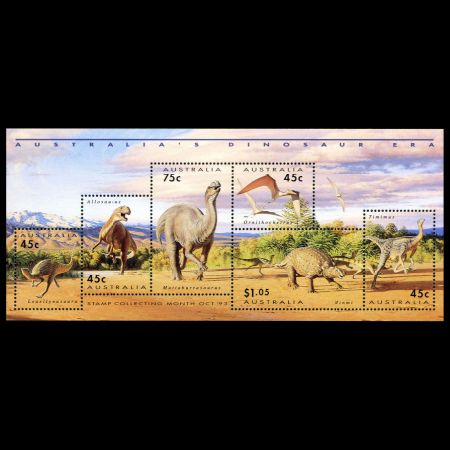
On October 1st 1993, Australian Post issued the set of 6 stamps "Dinosaur Era". These stamps depict 5 dinosaurs and a pterosaur (flying reptile).
These stamps were issued in several formats:
- Individual Sheets
- Mini-Sheet of all 6 stamps
- Two stamps of the set were issued as self-adhesive in a booklet of and boxes with rolls of 100 and 200 stamps each
- The Mini-Sheet was surcharged with golden mark at "World Philatelic Exhibition in Bangkok", Thailand that took place between October 1 and 10, 1993; "Sydney Stamp and Coin Show" that took place between October 15 and 17.
- The cover of the booklet with the self-adhesive stamps was surcharged at various philatelic exhibitions too.
Turning back the clock to the late 1800s, the first Australian dinosaurs were discovered but remained extremely rare among Australian fossils. Between 1932 and 1981 no new dinosaur research was carried out, though in recent years some exciting discoveries have been made.
Dinosaurs dominated Earth for more than 160 million years. The stamps in the Mini-Sheet shows a scene from the early Cretaceous period in Australia (more than 100 million years ago) - a pterosaur and some of the warm-blooded dinosaurs that thrived in the Dinosaur Cove area under the polar weather conditions.
 |
| Ornithocheirus pterosaurus on stamp of Australia 1993, MiNr.: 1372, Scott: 1342. |
 |
| Leaellynasaura dinosaur on stamp of Australia 1993, MiNr.: 1370, Scott: 1343. |
During the 19th century, in England many fragmentary pterosaur fossils were found in the Cambridge Greensand.
First found in Australia in 1979, near Boulia in south-western Queensland. It was a coastal species, and had a wing span of about 2.5 metres.
Leaellynasaura About the size of a chicken with a skull only 6 centimetres long, Leaellynasaura was a bipedal herbivorous dinosaur. Its eyes were exceptionally large, as was the part of the brain dedicated to processing visual signals (the optic lobes). It would appear to have been adapted for life in semi-darkness. During much of the Cretaceous, when Leaellynasaura lived, Australia was far closer to the South Pole than it is now, and would have been almost continuously dark for two or three months of each year. It has been suggested that this little dinosaur, too small to migrate, remained active throughout the long winter.
Timimus This ornithomimosaur (ostrich mimic dinosaur), in 1993 it was known from two thigh bones discovered in 1992. It probably looked something like a big emu, but with strong arms and a long, stiff tail. It probably fed on both plants and small animals, and relied on its great speed to escape predators.
 |
 |
|
| Timimus dinosaur on stamps of Australia 1993, MiNr.: 1373, Scott: 1345 and Australia 2013, MiNr.: 4019, Scott: 3988. | ||
In 2013, Timimus was featured on Australian stamp again. In 1993, it was originally identified as an ornithomimosaur, but 20 years after, based on new fossils, it is thought to be a theropod, possibly a tyrannosauroid.
To date of the stamp issue, only one specimens of the dinosaur was known: Timimus hermani It was formally named and shortly described by Dr. Thomas Rich and his wife Patricia Vickers-Rich in 1993/1994.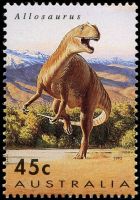 |
| Allosaurus dinosaur on stamp of Australia 1993, MiNr.: 1371, Scott: 1344. |
The generic name means "Tim's Mimic" and combines the name of both the discoverers' son Timothy Rich and palaeontologist Tim Flannery with a Latin mimus, "mimic", a reference to the presumed affinity of the species with the Ornithomimosauria. The specific name honours volunteer John Herman who, for many years, assisted the Dinosaur Cove project.
Allosaurus Allosaurus was the big predator of the North American Late Jurassic, 135 million years ago, so it is a surprise to find it in Australia some 10 to 20 million years later. It grew to 12 metres long, and weighed up to two tonnes.
Minmi
 |
| Minmi dinosaur on stamp of Australia 1993, MiNr.: 1375, Scott: 1347. |
This was a small (no more than 4 metres long), Early Cretaceous ankylosaur (armoured dinosaur), which was first found near Minmi Crossing in Queensland. It may have relied on its speed rather than its bony armour for protection from predators.
 |
| Muttaburrasaurus dinosaur on stamp of Australia 1993, MiNr.: 1374, Scott: 1346. |
All but the tail of this dinosaur has been found, near Muttaburra in Queensland.
Many of its bones were originally collected by local people, but after palaeontologists had excavated the remainder of the skeleton, a public appeal was made for the return of bones and the skeleton was reconstructed.
Muttaburrasaurus lived during the Early Cretaceous, 110 million years ago. It was similar in general shape to Iguanadon and like its relative, a plant eater. About 8 metres long, it probably walked and ran on its hind legs, but was able to move on all fours when feeding. Its thumb claw was a flattened spike which may have been used for defence.
The broad head ended in a horny beak which was used to tear leaves, twigs and fruit from trees; further back in the jaws were shearing teeth to slice up the food. The top of the snout was expanded into a strange, hollow dome, similar to those seen in some duck-billed dinosaurs.
Connected to the nasal passages, these are generally considered to have been resonating chambers, allowing the dinosaurs to produce loud noises either as part of their mating ritual or to scare predators. Muttaburrasaurus probably lived in herds.
| The stamps designer, Peter Trusler, explains about his work on reconsruction of prehostoric animals. |
Products and associated philatelic items
| Mini-Sheets (clean and surcharged) | ||
| Original | Surcharged at stamp shows in 1993 | Surcharged in 2022 for "Impression Collection" of Australian post |
 |
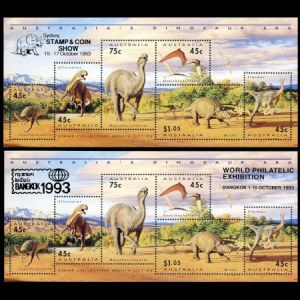 |
 |
| Surcharged postmarks used golden ink, but it seems as black on the scan | ||
| Official FDCs (clean and circulated) | ||
| Single stamps, from individual sheets | Mini-Sheet | Self-adhesive stamps |
 |
 |
 |
| The reverse side of an official FDC has some brief information about the stamps issue. | ||
| Postmarks On top of the official FDC postmark of Muttaburra, additional postmarks were issued by Australian Post at the same day, but in different locations across the country. |
||
| Official Postmark used on standard FDC (36x36mm) |
Local Post Office of Muttaburra (43x37mm) |
Brisbane, Philatelic Bureau (42x45mm) |
 |
 |
 |
| Melbourne (32x33mm and 33x35mm) |
Melbourne (32x36mm) |
Sydney (GPO: 27x29mm, Philatelic Bureau: 33x35mm) |
 |
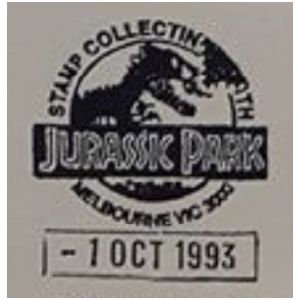 |
 |
| Myer Centre, Brisbane (49x38mm) |
Hughenden - not FDC | |
 |
 |
|
| permanent postmark of the city since 1988 | ||
| Official Souvenir materials | ||
| Presentation Pack | Maxi Cards | Some personalized FDCs |
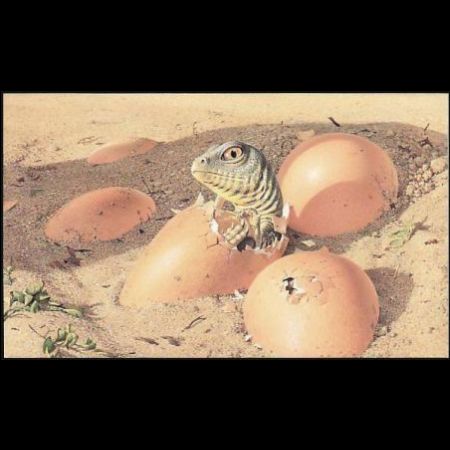 |
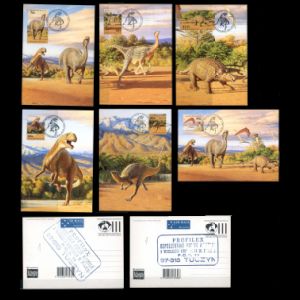 |
 |
| Example of Circulated Covers and Postcards | ||
 |
 |
 |
| Self-adhesive stamps | ||
| Stamps from the Box | Stamps from the booklet | Booklet of 10 |
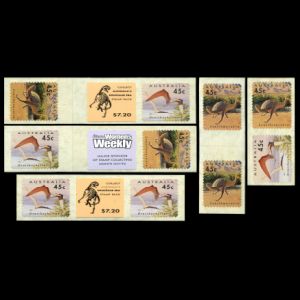 |
 |
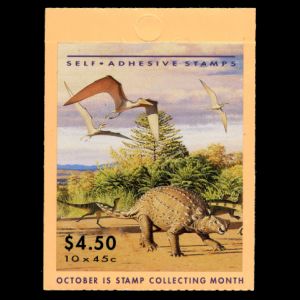 |
| These variations were sold to collectors in special collector pack | The cover of the booklet was surcharged on some stamps shows in 1993: [1], [2], [3] | |
| Official FDC surcharged at one of the stamps show in 1993 | Some Personalized FDCs | |
 |
 |
|
| Surcharged mark used golden ink, but it seems as black on the scan | ||
References:

|
- Technical details: reverse side of an official FDC, Australian Dinosaur Books, Biology on Stamps.
- Timimus: Wikipedia, "Tyrannosauroids from the Southern Hemisphere: Implications for biogeography, evolution, and taxonomy" by Rafael Delcourta and Orlando Nelson Grillob.
Acknowledgements:
Many thanks to Dr. Peter Voice from Department of Geological and Environmental Sciences, Western Michigan University, for the draft page review and his very valuable comments.
| <prev | back to index | next> |